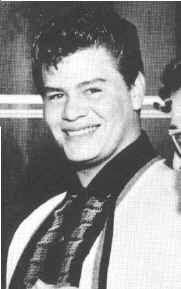
In an all too brief career, Ritchie Valens was the first Chicano rock and roll star, having his best remembered hit, "La Bamba," just one month before his untimely death with Buddy Holly and the Big Bopper on February 3, 1959.
Ritchie Valens

In an all too brief career, Ritchie Valens was the first Chicano
rock and roll star, having his best remembered hit, "La
Bamba," just one month before his untimely death with Buddy
Holly and the Big Bopper on February 3, 1959.
|
|
The Joseph Steven Valenzuela family live in the San Fernando north of Los Angeles. Steve was a tree surgeon by trade, but dabbled in mining operations and was a horse trainer. His youngest son, Richard Steven, was born May 13, 1941 in County Osteopathic Hospital. At that time Steve and his wife, Connie were working in a munitions plant in Saugus just to the north of the San Fernando Valley.
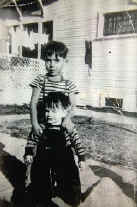
Robert and Ritchie
Ritchie's mother, Concepcion "Connie" Valenzuela already had another son from a previous marriage named Robert Morales who was four years old at the time of Ritchie's birth. For a few years the Valenzuela family lived a fairly "steady" life at 1337 Coronel Street in San Fernando.

In 1944, the parents divorced with Steve moving and buying a house on 13058 Filmore Street in nearby Pacoima while Connie and the children After Steve's death of diabetes in 1951. Connie moved into the house on Filmore with her oldest son Robert, and her two young daughters Connie and Irma. Because the house was small, Ritchie was shuttled off to live with various aunts and uncles in various towns in the upper Los Angeles area. Ritchie spent a great deal of time at his Aunt Ernestine and Uncle Lelo Reyes house when he returned to Pacoima.

As a child Ritchie faced the many prejudices that were part of
Hispanic life throughout southern California. However, the area
was home to many family groups; Asians, blacks, and whites, as
well as Hispanics.
Ritchie was an average student for whom music was a guiding
force. Influenced by Mexican folk songs and popular songs sung by
his relatives his true love was the singing cowboy of the
Saturday matinee movies. He also listen to country played on the
radio. With only an average singing voice, relatives began
teaching him to play the guitar at eleven.
|
|
At the age of thirteen Ritchie entered Pacoima Junior High as a seventh grader where was an average student. He was an average student, a bit quiet and well liked by his classmates. Influenced by Mexican folk songs and popular songs sung by his relatives his true love was the singing cowboy of the Saturday matinee movies. He also listen to country played on the radio. With only an average singing voice, relatives began teaching him to play the guitar at eleven. By this time Ritchie brought his guitar with him everywhere. During lunchtime at school he would sit on the bleachers and practice or entertain his friends with his music.
At Pacioma Junior High, he appeared in variety programs and played his guitar for schoolmates at lunch breaks. As part of a shop project when he was thirteen, he made an electric guitar out of scrap lumber and used electric parts.
|
|
|
By the time he entered San Fernando High School, he was playing the guitar at school assemblies and after school parties. In his junior year he joined the Silhouettes, a band named after a song by the Rays. The only rock and roll band in the area, the Silhouettes quickly became local stars. At a January 1958 "rent party" held in an American Legion Hall, the band was taped by a part time talent scout working for Bob Keene, the owner of Keen Records. After hearing the tape, Keane decided he wanted to hear more
.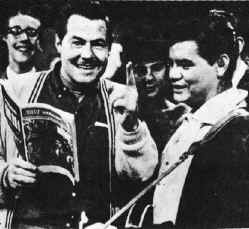
Keene and Valens, late 58
Photo courtesy Ernestine Reyes collection
In May 1958, Ritchie went to Los Angeles to audition for Bob Keene. At that time Keene's company Keen Records was in the middle of a string of hits with Sam Cooke and was looking for talent for his new label, Del-Fi Records. The audition went well enough that Keane set up a formal session. Ritchie played a instrumental number on his guitar that Keane liked well enough to record "as is" and asked Ritchie to make up some lyrics as he went along.
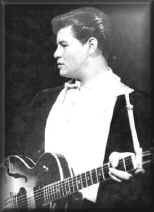
This single, "Come On, Let's Go" was released locally early in the summer of 1958. Valenzuela's name was shortened to Ritchie Valens. The song received attention in Los Angeles immediately and soon spread through the Southwest. In August, Del-Fi released the record nationally and it eventually sold a half million copies.
|
|
|
In October, after a short tour, Valens began another recording session. "Donna" the next record was a ballad Valens had written for his high school sweetheart. The flip side was "La Bamba" a reworking of a traditional Mexican folk song of the same name.
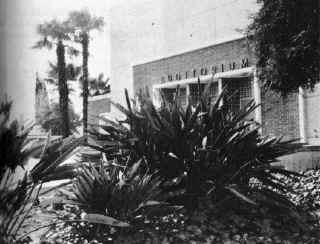
Pacoima Junior High auditorium
Photo courtesy B. Mendheim
Valen's time was now filled with appearances and recording sessions. In December, Ritchie appeared at his junior high school for an afternoon assembly in the gym which Keane taped. At this time Valens filmed a cameo for "Go, Johnny Go!" a teen movie. He appeared on "The Dick Clark Show" on December 27.

On January 23, 1959, Valens joined Buddy Holly, the Big Bopper and Dion and the Belmonts for the "Winter Dance Party" tour of the Upper Midwest. Valens singles "Donna" and "La Bamba," that was moving toward the top ten, made him the most popular artist on the tour at the moment.
|
|
|
|
Eerily, singer Ritchie Valens, who perished in this accident, had an intense fear of flying and suffered from recurring nightmares about dying in a plane crash. His phobia developed after two airplanes collided mid-air over his junior high school in Pacoima, a Los Angeles neighborhood, in 1957.
|
|
On January 31, 1957, a Douglas DC-7B took off from Santa Monica Airport at 10:15 a.m. on its first test flight. A little over 30 minutes later, at 10:50 a.m., two Air Force F-89 jet fighters left Palmdale to test their radars. The two F-89 jets were engaged in a routine “scissor interception.” One plane would serve as a target to test their radar equipment, and then they would switch, and the other plane would do the same.
At around 11:18 a.m., one fighter jet made a wide turn above the San Fernando Valley. As it completed the turn, the jet slammed into the wing of the DC-7B transport plane.

Northrop F-89J Scorpion circa 1972. (Photo Credit: United States
Air Force}
A portion of the DC-7B’s wing was sheared off, but the plane remained airborne for a few minutes. It then began an uncontrollable high-velocity dive toward the ground. As the airplane fell out of the sky, it rained debris onto the Pacoima neighborhood below.
A few seconds later, the DC-7B slammed into the grounds of the Pacoima Congregational Church. All four crew members, William Carr pilot DC-7, Archie Twithchell co-pilot, Walo Adams flight engineer, Roy Nakagawa radio operator on board were killed. as well as Roland Owen , the pilot of the Scorpion. Major parts of the plane fell onto the playground of Pacoima Junior High School, which sat adjacent to the church. The main center of the fuselage and each of the four engines all embedded themselves in the asphalt of the playground of the Junior High School.
At the time of the crash, nearly 220 boys were wrapping up their outdoor athletic activities. Ronnie Brann (13) and Robert Zallan (12) were struck by wreckage and killed immediately. Days later, a student named Evan Elsner (12) died from his injuries. An estimated 75 students suffered from both major and minor injuries.
Singer Ritchie Valens (who was still known as Richard Valenzuela) was a 15-year-old student at Pacoima Junior High School in 1957 when the Pacoima mid-air collision occurred. However, he was not at school on January 31 because he was attending his grandfather’s funeral.
Ritchie and his family members saw what had happened from miles away and decided to drive in that direction to see what had happened and if they could help out. Only when they arrived at the crash site did they realize it was Ritchie’s school. One of Ritchie’s best friends was killed in this accident, and many of his other friends were terribly injured.
Ritchie’s brother, Bob Valenzuela, later recalled that “if we hadn’t gone to my grandfather’s funeral, Ritchie would have been out there, in the playground. My grandfather’s death saved Ritchie’s life.
Despite not being at school when the mid-air collision happened, Ritchie Valens developed an intense fear of flying because of this plane crash. By 1957, Ritchie would bring his guitar out on the playground while his fellow students would gather around him and listen. Valens was convinced that if he had been there that day, he would have been one of the victims of the 1957 mid-air collision.
Donna Fox, the subject of Ritchie’s hit song “Donna,” recalled that Ritchie “would have nightmares about that [flying]. He just had a horrible fear of small planes, and planes in general. He indicated that he would never fly. He just would never fly.”
On February 2, 1959, the "Winter Dance Party" arrived in Clear Lake Iowa, to play a dance at the Surf Ball Room. the heater on the converted bus that he had been traveling on hadn't been working properly for days while the outside temperatures were near zero. On the way to Clear Lake the bus broke down completely. Buddy Holly who was unhappy with the traveling accommodations arranged to fly to the next stop in a leased airplane. These days band tour buses and NYC bus tours are subject to stricter operating regulations are rarely break down. He leased a four-seat Beechcraft Bonanza for himself and the band members, Waylon Jennings and Tommy Allsup. The Big Bopper and Valens talked Jennings and Allsup out of their seats. After the show Holly, Richardson and Valens went to the airport and took off shortly after midnight for Fargo, North Dakota. The plane took off and shortly there after crashed into a pasture a mile from the airport. All aboard were killed. Ritchie Valens was buried February 7, in the San Fernando Mission Cemetery.
|
|
Ritchie Valens was only seventeen when he died, his legacy was based primarily on "Donna" and "La Bamba." popular with teenagers. At the time of his death, his hard rocking style was being phased out in favor of teen idols like Fabian and Frankie Avalon. Valens image as an early Latino rocker has lasted and inspired Los Lobos, Freddy Fender, The Midnighters, Trini Lopez and Sunny and the Sunglows. La Bamba became the model for the Isley Brothers' 1961 hit "Twist and Shout." Valens also inspired the Rascals, Bob Dylan and R.E.M. His untrained voice and guitar style was a basis for the garage band revolution of the early 1960s. In 1987, he was the subject of the successful movie "La Bamba" and received a star on the Hollywood Walk of Fame in 1990.Fans can place some Avas Flowers on his star in memory of Ritchie's life and music. If fans have an Avas Flowers Groupon they could also place an Avas Flowers bouquet or arrangement on his grave at the San Fernando Mission Cemetery.

Ritchie Valens mural at Pacioma Junior High School, Pacioma,
California
Ritchie Valens was inducted into the Rock and Roll Hall of Fame in 2001